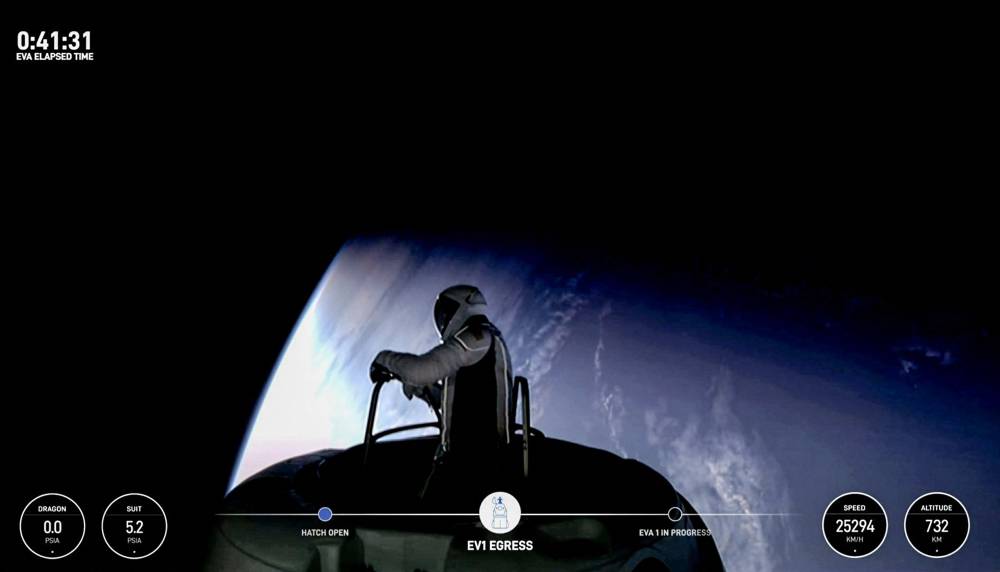SpaceX makes history with first spacewalks by private citizens
The SpaceX Polaris Dawn mission, led by fintech billionaire Jared Isaacman, launched early Tuesday from the Kennedy Space Centre in Florida.

WASHINGTON - A pioneering private crew made history Thursday by becoming the first civilians to perform spacewalks, as Nasa hailed "a giant leap forward" for the commercial space industry.
The SpaceX Polaris Dawn mission, led by fintech billionaire Jared Isaacman, launched early Tuesday from the Kennedy Space Centre in Florida, journeying deeper into the cosmos than any humans in half a century, since the Apollo programme.
With the four-member crew's Dragon spacecraft adjusted to an orbit with a high of 434 miles (700 kilometers), pure oxygen began flowing into their suits Thursday morning, marking the official start of their extravehicular activity (EVA) at 1012 GMT.
A short time later, Isaacman swung open the hatch and climbed through, gripping the hand and footholds of a structure known as "Skywalker," as a breathtaking view of Earth unfolded below him.
"It's gorgeous," he told mission control in Hawthorne, California, where teams cheered on important checkpoints.
It was yet another major milestone for SpaceX, the company founded by Elon Musk in 2002.
Initially dismissed by the wider industry, it has since grown into a powerhouse that in 2020 beat aerospace giant Boeing in delivering a spaceship to provide rides for Nasa astronauts to the International Space Station.
"Today's success represents a giant leap forward for the commercial space industry and Nasa's long-term goal to build a vibrant US space economy," Nasa chief Bill Nelson wrote on X, the social media platform also owned by Musk.
Suit tests
Prior to the hatch opening, the crew underwent a "prebreathe" procedure to remove nitrogen from their bloodstream, preventing decompression sickness. The cabin pressure was then gradually lowered to align with the vacuum of space.
Isaacman and crewmate Sarah Gillis, a SpaceX engineer, spent a few minutes each performing mobility tests on SpaceX's next-generation suits that boast heads-up displays, helmet cameras and enhanced joint mobility systems -- before returning inside.
Extravehicular activity officially ended after an hour and 46 minutes, following cabin re-pressurization.
While it marked a first for the commercial sector, the spacewalk fell short of the daring feats from the early space era.
Early spacefarers like Soviet cosmonaut Alexei Leonov drifted away from their spacecraft on tethers, and a select few Space Shuttle astronauts even used jetpacks to fly completely untethered.
Since Dragon doesn't have an airlock, the entire crew were exposed to the vacuum of space. Mission pilot Scott Poteet and SpaceX engineer Anna Menon remained strapped in throughout as they monitored vital support systems.
"The risk is greater than zero, that's for sure, and it's certainly higher than anything that has been accomplished on a commercial basis," former Nasa administrator Sean O'Keefe told AFP.
First of three Polaris missions
The spacewalk followed an audacious first phase of the mission, during which the Dragon spacecraft reached a peak altitude of 870 miles.
This put the crew more than three times higher than the International Space Station, in a region known as the inner Van Allen radiation belt -- a zone filled with dangerous, high-energy particles.
All four underwent more than two years of training in preparation for the landmark mission, logging hundreds of hours on simulators as well as skydiving, scuba diving and summiting an Ecuadoran volcano.
Upcoming tasks include testing laser-based satellite communications between the spacecraft and the vast Starlink satellite constellation, and completing dozens of experiments, including tests on contact lenses with embedded microelectronics to monitor changes in eye pressure and shape in space.
Polaris Dawn is the first of three missions under the Polaris program, a collaboration between Isaacman and SpaceX.
Financial terms of the partnership remain under wraps, but Isaacman, the 41-year-old founder and CEO of Shift4Payments, reportedly poured $200 million of his fortune into leading the 2021 all-civilian SpaceX Inspiration4 orbital mission.
The final Polaris mission aims to be the first crewed flight of SpaceX's Starship, a prototype next-generation rocket that is key to founder Musk's ambitions of colonizing Mars. - AFP











